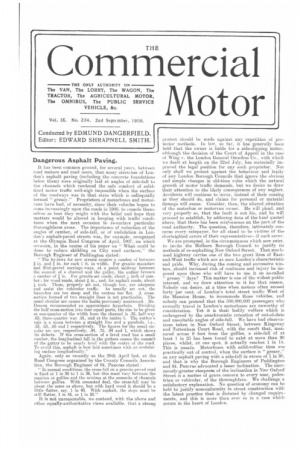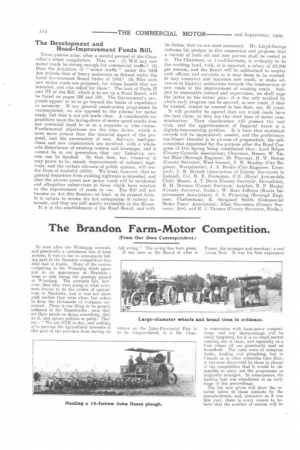Dangerous Asphalt Paving.
Page 1

Page 2

If you've noticed an error in this article please click here to report it so we can fix it.
It has been common ground, for several years, between road makers and road users, that many stretches of London's asphalt paving (including the concrete foundations below them) were originally laid at angles of side-fall to the channels which rendered the safe conduct of solidtired motor, traffic well-nigh impossible when the surface of the roadways was in that state which is colloquially termed " greasy." Proprietors of motorbuses and motorvans have had, of necessity, since their vehicles began to come increasingly upon the roads in 1906, to console themselves as best they might with the belief and hope that matters would be altered in keeping with traffic conditions when the next occasion to re-surface particular thoroughfares arose. The importance of reduction of the angles of camber, of side-fall, or of undulation in London's asphalt-paved streets was, for example, recognized at the Olympia Road Congress of April, 1907, on which occasion, in the course of his paper on " What could be done to reduce skidding on City road surfaces," the Borough Engineer of Paddington stated :
" The by-laws for new streets require a camber of between
in. and in. for each 1 ft. in width. For granite macadam and flint-gravel carriage-ways, at a point midway between the summit of a channel and the galley, the author favours a camber of 2 in. For granite-set roads, about inch of camber : for wood roads, about in., and, for asphalt roads, about inch. These, properly set out, though low, are adequate and assist the vehicular traffic. As usually set out, the haunches are too steep and the centres too flat. A crosssection formed of two straight lines is not practicable. The usual circular arc causes the faults previously mentioned. Mr. Deacon recommended an approximate hyperbola. Dividing the half cross-section into four equal parts, the rise to be given at one-quarter of the width from the channel is .55, half-way .65, three-quarter way .81, and at the centre 1. The author's rule is a mean between a straight line and a parabola, i.e„ .53, .65, .85 and 1 respectively. The figures for the usual circular arc are, respectively, .44, .75, .94 and 1, which shows its defects. If the cross-section of a level road has a small camber, the longitudinal fall in the gutters causes the summit of the gutter to be nearly level with the centre of the road. To avoid this, asphalt is best laid sometimes with an undulating surface longitudinally."
Again, only so recently as the 29th April last, at the Road Congress organized by the County Councils Association, the Borough Engineer of St. Pancras stated : "In normal conditions, the cross-fall on a granite-paved road is fixed at 1 in 30 to 1 in 36, but this must vary between the maxima at gullies and the minima at the summits of channels between gullies. With creosoted deal, the cross-fall may be about the same as above, but with hard wood it should be a little flatter, say, 1 in 40. With asphalt. the slope must be still flatter, 1 in 45, or 1 in 50."
It is not unreasonable, we contend, with the above and other equally-authoritative views available, that a strong
protest should be made against any repetition of premotor methods. In law, so far, it has generally been held that the owner is liable for a side-slipping motor, although the decision of the Court of Appeal in the case of Wing v. the London General Omnibus Co., with which we dealt at length on the 22nd July, has materially improved the legal position for any such proprietor. Not only shall we protest against the behaviour and laxity of any London Borough Councils that ignore the obvious and simple changes in old-time rules which the natural' growth of motor traffic demands, but we desire to draw their attention to the likely consequences of any neglect. Accidents will continue to occur, instead of their ceasing as they should do, and claims for personal or material damage will ensue. Consider, then, the altered situation of the motorbus or motorvan owner. He will plead, and very properly 80, that the fault is not his, and he will proceed to establish, by adducing data of the kind quoted above, that there has been misfeasance on. the part of the road authority. The question, therefore, intimately concerns every ratepayer, for all stand to be victims of theshortsighted errors of their representatives—if such occur.
We are prompted, in the circumstances which now exist, to invite the Holborn Borough Council to justify its methods of re-asphalting New Oxford Street. That muchused highway carries one of the two great lines of Eastand-West traffic which are at once London's characteristic and pride. Why, during the coming and successive winters, should increased risk of confusion and injury be imposed upon those who will have to use it on so-called " greasy " days? This matter is one of the widest public interest, and we draw attention to it for that reason. Nobody can desire, at a time when motors often exceed forty per cent. of London's total street traffic West of the Mansion House, to incommode those vehicle's, and nobody can pretend that the 500,000,000 passengers who annually travel in London's motorbuses are unworthy of consideration. Yet it is their bodily welfare which is endangered by the anachronistic retention of out-of-date and unsuitable angles of side-fall. We have had observations taken in New Oxford Street, between Kingsway and Tottenham Court Road, with the result that, measured across 8 feet from the gullies, a side-fall of at least 1. in 25 has been found to exist at more than 30 places, whilst, at one spot, it actually reaches 1 in 14. This is unsafe. Motorbuses with solid-rubber tires are practically out of control, when the surface is " greasy," on any asphalt paving with a side-fall in excess of 1 in 30, and that is why the Borough Engineers of Paddington. and St. Pancras advocated a lesser inclination. The enor-mously-greater steepness of the inclination in New Oxford Street is a matter of grave concern to every user, pedestrian or vehicular, of the thoroughfare. We challenge a satisfactory explanation. No question of economy canbe. held to justify nonconformity in street construction with the latest practice that is dictated by changed requirements, and this is more than ever so in a 'case which. occurs in the heart of London.
The Development and Road-Improvement Funds Bill.
Three queries arise, after a careful perusal of the Chancellor's latest compilation. They are : (I) Will any new motor roads be strong enough for commercial traffic? (2) Does the definition of " motor traffic " under the 1903 Act include that of heavy motorcars as defined under the Local Government Board Order of 1904? (3) Why such new motor roads are proposed, for whose benefit they are intended, and who asked for them ? The text of Parts IT and III of the Bill, which is to set up a Road Board, will be found on pages 528 and 529. The Government's proposals appear to us to go beyond the limits of expediency or necessity. If any general construction programme be contemplated, we are opposed to the scheme for motor roads, but that is not yet made clear. A considerable expenditure upon the laying-down of motor speed-tracks does not commend itself to 118 as a requisite or wise course. Fundamental objections are the time factor, which is even more serious than the financial aspect of the proposal, and the uncertainty of cost, Surveys, land-purchase and new construction are involved, with a wholesale disturbance of existing centres and frontages, and it cannot be in our generation that any linked-up system can be finished. By that date, too, whenever it may prove to be, steady improvements of ordinary highways, and the certain advance of public opinion, will render them of doubtful utility. We trust, however, that no general departure from existing highways is intended, and that the powers anent new motor roads will be incidental and altogether subservient to those which have relation to the improvement of roads in me. The Bill will not become an Act this Session—at least, in its present form. lt is certain to arouse the hot antagonism of railway interests, and they are still nearly irresistible in the House.
It is in the establishment of the Road Board, and with its duties, that we are most concerned. Mr. Lloyd-George redeems his pledges in this connection and proposes that a variety of both old and new powers shall be vested in it. The Chairman, or Vice-Chairman, is evidently to be the working head, with, it is reported, a salary of .#2,3,0Q0 per annum, and the Board will be authorized to employ such officers and servants as it may deem to be wanted. It may construct and maintain new roads, or make advances to highway authorities towards the construction of new roads or the improvement of existing roads. Subject to reasonable control and supervision, we shall urge the latter as the better plan : it is the only method by which early progress can be assured, as new roads, if they be wanted, cannot be created in less than, say, 30 years.
It will probably be agreed that our trunk roads have the first claim, as they are the chief lines of motor communication. Their classification will present the real crux, and the apportionment of Imperial funds is a slightly-less-exacting problem. It is here that statistical records will be imperatively needed, and the preliminary machinery therefor is in process of preparation, the subcommittee appointed for the purpose after the Road Congress of this Spring being constituted thus: Lord helper (County Councils Association), Chairman, Messrs. W. Nisbet Blair (Borough Engineer, St. Pancras), H. W. Bowen (County Surveyor, West Sussex), J. W. Bradley (City Engineer, Westminster), J. A. Brodie (City Engineer, Liverpool), J. B. Birkett (Association of County Surveyors in Ireland), Col, R. E. Crompton, C.B. (Royal Automobile Club), Messrs. A. T. Davis (County Surveyor, Shropshire), R. H. Dorman (County Surveyor, Antrim), E. P. Hooky (County Surveyor, Notts.), W. Rees Jeffreys (Roads Improvement Association). J. S. Pickering (Borough Engineer, Cheltenham), E. Shrapnel' Smith (Commercial Motor Users' Association), Allan Stevenson (County Surveyor, Ayr), and R. J. Thomas (County Surveyor, Bucks.).




















